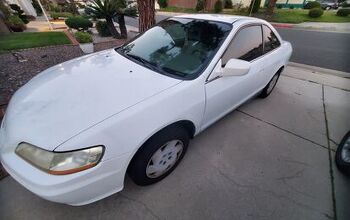Curbside Classic: Incredible Steam-Injected, 12 Second 1/4 Mile, 75 MPG 1978 Mercury Bobcat

My gig is to wander the streets of Eugene and hopefully stumble onto something worthy of your attention. Sometimes, my wildest expectations are exceeded, and then exceeded again. Walking down Willamette Street, I see the distinctive rear hatch of what I take to be a Pinto. Nice enough. But no, this is a Mercury Bobcat; quite a find in this day and age. I start snapping away. And then the owner shows up and tops it all: he’s converted this Bobcat to a steam injection system of his own invention, and it’s going to pull twelves in the quarter mile and get 75 mpg. Incredible!
Incredible indeed. Oh, and I have a 200 mpg carburetor design that the oil companies paid me a fortune to not reveal. But let’s not jump to conclusions before we’ve given his years of (still incomplete) labors its fifteen minutes of fame. The fact that he’s using a 1978 Bobcat as the basis of his rolling experiment alone deserves attention. It also makes it easier to imagine what kind of stereotypical personality this inventor is. Why didn’t I ask him to pose with his car?
Before you think this is all some BS hype to jack up our stats or some old recycled April 1 post, I did take pictures of his steam injection system from a photo in his album, and we popped the hood to confirm evidence of his currently partially-dismantled set up. There’s the steam “distributor”, copper lines, kaneuter valves, etc…this is not just some glorified water injection system; the “steam” will be 500 degrees hot, and rapidly expand in the cylinder. Damn; in all my excitement, I forgot to ask him how he was going to heat it up, without using a boiler of some sort. I’m sure he’s got it covered though.
He showed me detailed drawings and photos of numerous valves, manifolds and other components worthy of an overly complicated home hot-water heating system. And I heard his sad story of living on disability income; how he was using food money to try to finish building the components so that he could qualify for a $270k DOE grant or something like that. And he assured me that when (if) the Bobcat was completed, twelve-second quarter miles and 75 mpg economy were a slam dunk. Sure, I see no problem; but he might consider some bigger rubber on the rear wheels before he sets out to prove his claim on the drag strip and vaporizes those little 13″ tires.
You might be wondering just what drove him to using a Mercury Bobcat for his little steamy wonder (I was), other than a quirk of personality. There’s a reason. Well, it didn’t exactly have to be a Bobcat, just any of the millions of the Ford vehicles that used the 2.3 OHC Pinto-derived engine, which still powered Rangers until quite recently. The later versions of that engine had a twin-plug setup, and held the key to fitting the steam injectors, which are clearly visible in the picture. His engine came from one of these Rangers, but because its fuel injection system was too complicated not suitable to the inventor, he went to considerable length to convert it back to a carburetor set up. Steam injection: good; fuel injection: not.
Its not like anyone makes adapter plates for that particular job (converting back to a carb intake manifold) either. He showed me pictures of his handiwork, and told me plaintively “you have no idea what it took to make that adapter by hand”. I didn’t ask what he meant “by hand”, but I hope some power tools were involved along the way. Moving along…
He anticipates a four-fold increase in combustion chamber pressure as the result of the steam injection. He made reference to the Crower six-stroke engine, which I’ve read about, but somehow he had invented the solution to incorporating the gasoline combustion and steam expansion cycles into one. Maybe I was just hungry and had low blood sugar, but his explanation is all a bit hazy today, despite this encounter taking place just yesterday. I’m just not going to make a good venture capitalist. I’m sure the DOE will have an easier time of getting it.
Or perhaps I was just distracted with his Bobcat. They’ve become almost as rare as six-stroke engines. Mercury’s “grill engineered” Pinto was offered to a less-than-enthusiastic public from 1975 through 1980. It was Mercury’s desperate response to the 1974 energy crisis, but never sold more than at a tiny fraction of the Pinto’s sales numbers. 1978 was a particularly inauspicious year to buy a Bobcat, if performance was even vaguely on your mind, which it probably wasn’t. It marked the low-water year for engine output: the 2.3 (pre-steam injection) made 88 horsepower, and if that wasn’t enough, you could spring for the 2.8 V6, rated at 90 hp. That probably represented one of the more expensive horsepower-per-dollar investments.
In 1981, the Escort-rebadge Lynx chased the Bobcat from the scene. Makes me realize I haven’t seen that species from the house of the sign of the cat in a long time. Maybe I’ll stumble upon one soon, and it will turn out to be be powered by a cold-fusion engine. Otherwise, it’ll be hard to top this scalding-hot Bobcat.

More by Paul Niedermeyer
Latest Car Reviews
Read moreLatest Product Reviews
Read moreRecent Comments
- Lou_BC Well, I'd be impressed if this was in a ZR2. LOL
- Lou_BC This is my shocked face 😲 Hope formatting doesn't fook this up LOL
- Lou_BC Junior? Would that be a Beta Romeo?
- Lou_BC Gotta fix that formatting problem. What a pile of bullsh!t. Are longer posts costing TTAC money? FOOK
- Lou_BC 1.Honda: 6,334,825 vehicles potentially affected2.Ford: 6,152,6143.Kia America: 3,110,4474.Chrysler: 2,732,3985.General Motors: 2,021,0336.Nissan North America: 1,804,4437.Mercedes-Benz USA: 478,1738.Volkswagen Group of America: 453,7639.BMW of North America: 340,24910.Daimler Trucks North America: 261,959








































Comments
Join the conversation
Of course the plan makes no sense until you figure in the 1.21 jigowatts added by the flux capacitor.
This is really awesome and the thanks Paul about this information on classic cars. The classic cars are one of the most amazing cars and they are the best performance cars. The classic cars has good engine speeds and they have to be maintained with care.carinsuranceclassic.co.uk